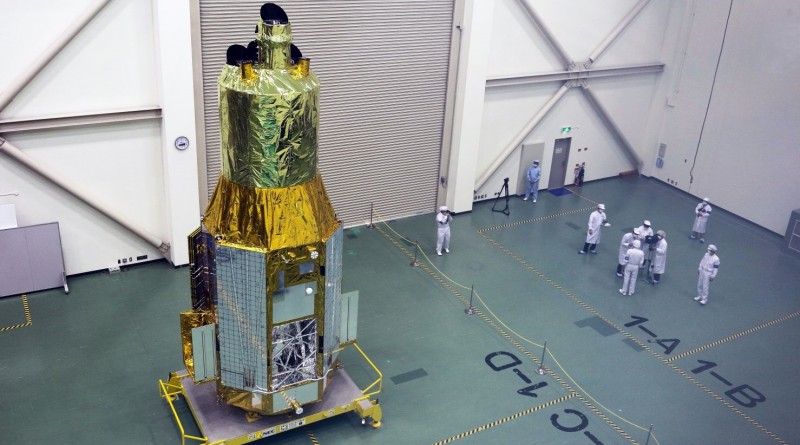Advanced X-Ray Observatory ready for liftoff atop Japanese H-IIA Rocket
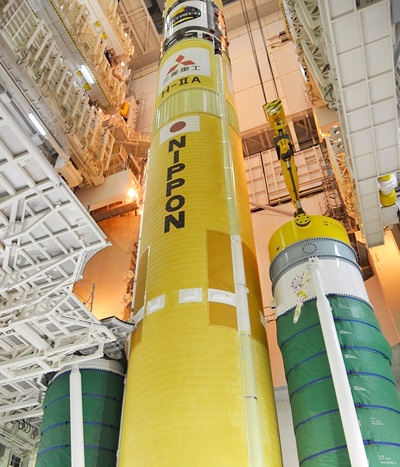
Japan’s Astro-H X-Ray Observatory is set for liftoff atop an H-IIA rocket on Wednesday after several days of weather-related delays. Launch from the Tanegashima Space Center is set for a 45-minute window opening at 8:45 UTC to mark the start of a 14-minute ascent mission to reach an orbit over 500 Kilometers in altitude from where the Astro-H spacecraft will deliver the sharpest energy measurements for high-energy X- and gamma-rays.
Astro-H, weighing in at 2,700 Kilograms, hosts four telescopes combining imaging detectors with spectrometers sensitive in the soft and hard X-ray spectrum to deliver imagery of X-ray sources and extract high-resolution energy spectra for the same targets. Additionally, the spacecraft is outfitted with a Soft Gamma-Ray Detector to cover the high-energy regime with high sensitivity and resolution.
Employing pairs of telescopes for soft and hard X-rays enables the observatory to deliver high-resolution spectral data of targets while simultaneously delivering X-ray imagery of the same sources. The spectrometers are expected to deliver the highest energy resolution ever achieved in measurements at energies of 3 to 100 Kilo-Electronvolt. This is possible through the use of microcalorimeter detectors that, compared to the CCD detectors of previous missions, have a far better energy resolution. Astro-H would become the first craft to successfully employ such a detection system in an orbital mission after several sub-orbital flights and failed orbital missions.
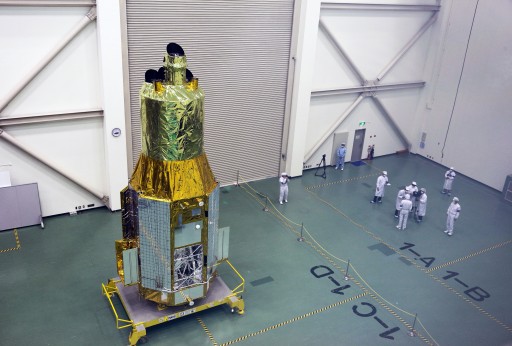
Simultaneous measurements across a broad energy range from soft X-rays to gamma-rays at exceptional resolution will open up an enormous space of discovery for a variety of objects, enabling scientists to probe the most extreme environments found in the universe. The Astro-H mission is expected to deliver breakthrough results in a diverse area of science, ranging from the large-scale structure of the universe and its evolution to the behavior of matter in strong gravitational fields, the physical conditions at sites of cosmic-ray acceleration, and the study of dark matter in galaxy clusters.
>>Astro-H Spacecraft & Instrument Overview
Sitting atop the H-IIA Rocket, Astro-H is accompanied by three smaller satellites – ChubuSat-2 & 3, and Horyu 4. A commercial CubeSat payload from the United States had to be cut from the payload manifest due to scheduling issues and installed in its place is a mass simulator.
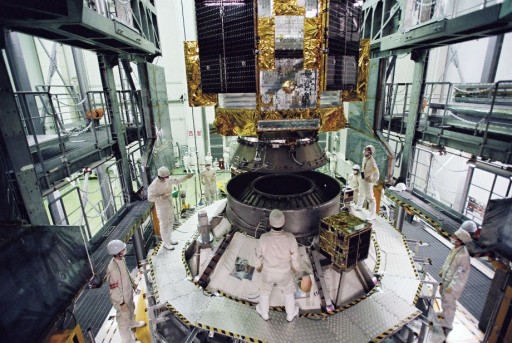
ChubuSat 2 and 3 each weigh approximately 50 Kilograms and host imaging, radiation and communication payloads. The spacecraft host visible imaging payloads for Earth observation at a resolution of around ten meters. Infrared cameras are employed to study a technique for monitoring space debris and the satellites are outfitted with a radiation detector system to examine radiation from the sun and Earth.
Horyu 4, also known as AEGIS – Arc Event Generator and Investigation Satellite, is planned to carry out a demonstration mission of ten payloads. The primary objective is the test of High-Voltage Solar Arrays and associated plasma mitigation techniques. Also, the satellite compares the degradation of different solar cell coatings, tests a vacuum arc thruster system, and deploys a material science experiment to orbit evaluating the response of different polymers to prolonged exposure to space.

The Astro-H spacecraft made its way to the Tanegashima Space Center in late 2015 and the H-IIA rocket was assembled by its operator Mitsubishi Heavy Industries in late December starting with the installation of the 37-meter tall core stage atop the launch table. Next was the installation of the cryogenic second stage and the attachment of the two SRB-A solid rocket boosters. Fueled for flight and fully checked out, Astro-H was handed over by JAXA for installation atop the launch vehicle, along with the secondary payloads hosted by adapters installed around the primary payload adapter system.
Liftoff was originally scheduled for Friday but had to be pushed due to an unfavorable weather outlook calling for persistent winds and adverse weather with clouds containing a freezing layer, causing violations of weather criteria over the weekend and into this week. JAXA announced on Sunday that the launch was rescheduled for Wednesday after forecast models showed weather would clear up by mid-day on Tuesday, permitting an overnight rollout and countdown to set up for liftoff on Wednesday.
H-IIA 202 has a liftoff weight of 285,000 Kilograms standing 53 meters tall with a core diameter of 4 meters using a two-stage stack with two Solid Rocket Boosters attached to the first stage. The rocket is capable of delivering payloads of up to 11,000 Kilograms to Low Earth Orbit.
>>Launch Timeline & Ground Track Map
Countdown & Launch Sequence
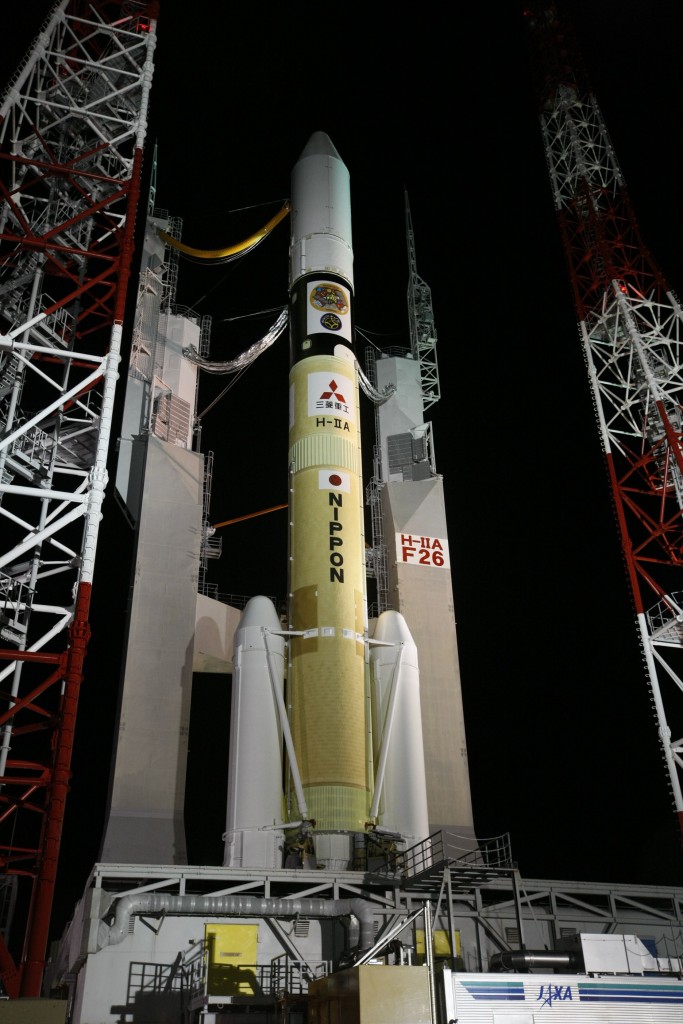
Mission Managers will meet up on Tuesday, around 15 hours prior to the planned liftoff time for a final review of launch vehicle and payload readiness as well as weather conditions before providing the approval for the rollout of the H-IIA rocket. Engineers will close out the H-IIA rocket and its launch platform before opening up the doors of the Vehicle Assembly Building to begin the 30-minute rollout of the vehicle around 14 hours prior to launch.
After arriving at the sea-side launch pad, technicians connect data and electrical lines and put propellant umbilicals in place before completing final fueling preparations and close-outs of the rocket. About eight hours before launch, teams evacuate the launch pad to get ready for the long propellant loading sequence.
Beginning at about X-7 Hours and 45 Minutes, the complex tanking sequence gets underway with the pressurization and chilldown of ground support systems handling the -183-degree Celsius LOX and -253°C LH2. Fueling goes through a number of steps including ground support system chilldown, propellant tank chilldown and propellant loading, before tanking enters replenish mode.
The propellant loading sequence takes approximately three hours until 116,600 Kilograms of cryogenics needed for launch are loaded. Replenishing the propellants as they boil off, the tanks are kept at topping level until late in the countdown.
The majority of the countdown will be spent with extensive tests of the launch vehicle’s flight control system, checks of all electronics and controllers and verifications of the radio link between the launcher and the ground. Over the final hour of the countdown, last-minute items will be closed out and the vehicle will be reconfigured for the Automatic Countdown Sequence starting just 4.5 minutes prior to blastoff.
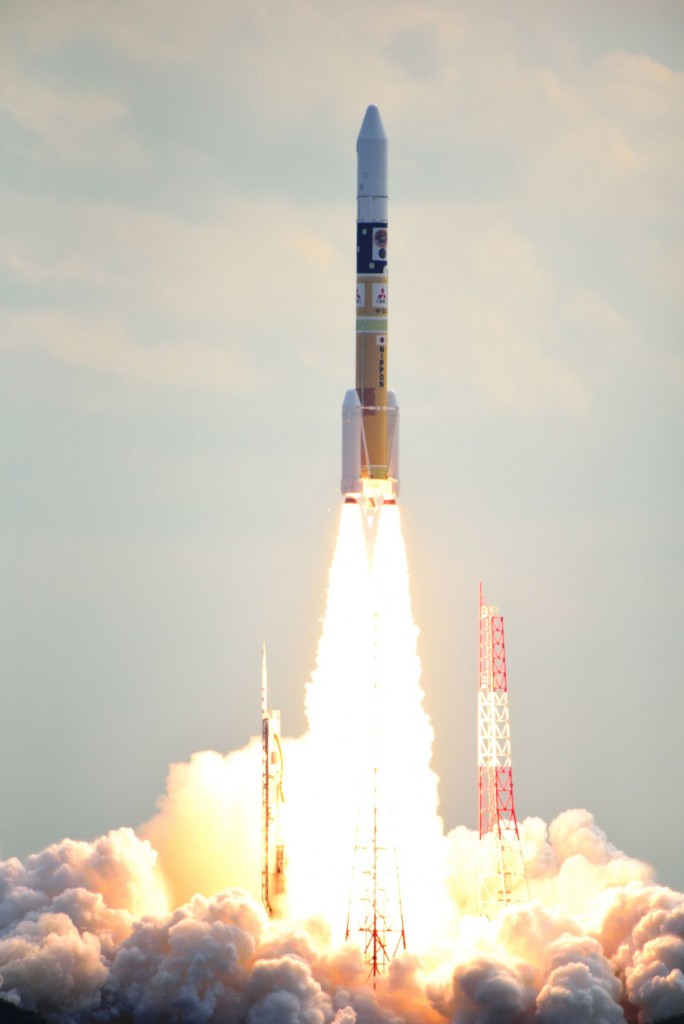
As computers are given control of the countdown, H-IIA’s Propellant Tanks will be pressurized for flight. At X-3 minutes, the launch vehicle is switched to internal power while Astro-H will have been switched to battery power ahead of the final countdown sequence. One minute before liftoff, thousands of Kilograms of water are being poured over the launch platform to suppress the acoustic loads at ignition & liftoff.
Launch Vehicle Ordnances will be armed at X-30 Seconds and the Guidance System of the Vehicle is switched to Flight Mode 12 Seconds later before the sparklers underneath the LE-7A main engine ignite to burn off residual Hydrogen.
Ignition Sequence Start is commanded at X-5.2 Seconds and the LE-7A Engine soars to life as the turbopumps spin up to flight speed – monitored by on-board computers to make sure the engine is healthy before the booster ignition command is issued at T-0 to commit the vehicle to launch.
At the moment of booster ignition, the H-IIA rocket leaps off its pad with a total thrust of 571,000 Kilogram-force with the two boosters delivering 76% of the total thrust at liftoff, providing the extra kick needed to send Astro-H into orbit. H-IIA will make a short vertical ascent before beginning to pitch and roll in order to get aligned with its precisely planned ascent path taking the launch vehicle to the south-east for a trip across the Pacific Ocean. Screaming away from Japan’s southern tip, H-IIA quickly passes Mach 1 and Maximum Dynamic Pressure.
The two boosters burn until T+1 minute and 39 seconds – burnout will be sensed by the declining pressure in the combustion cambers. Booster jettison occurs 56 Kilometers in altitude at T+1:48 as both SRBs separate simultaneously after completing their job of helping accelerate the vehicle to 1.5 Kilometers per second.
Powered flight continues on the LE-7A engine of the first stage alone, generating 109,300 Kilogram-force of thrust by burning about 260 Kilograms of cryogenics per second.
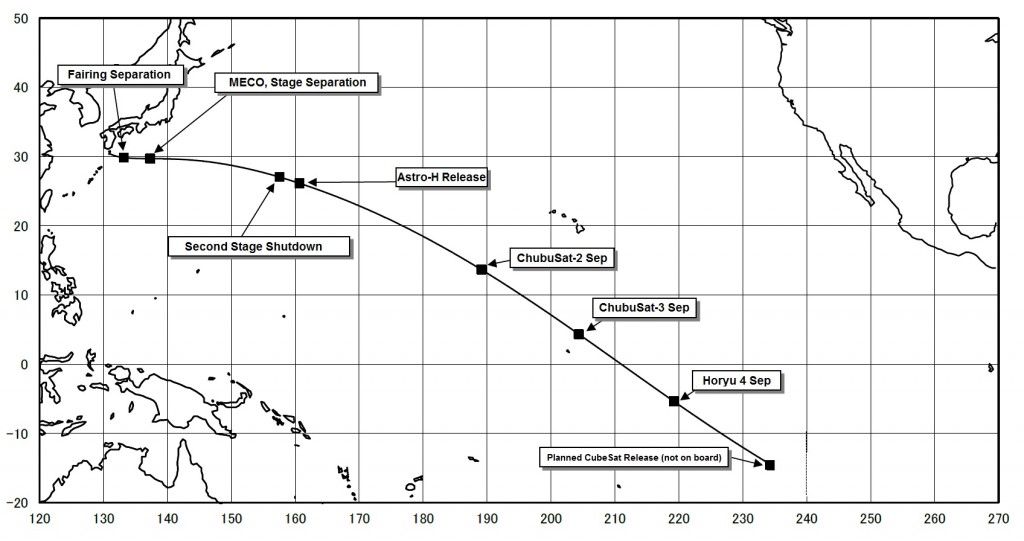
By T+4 minutes and 15 seconds, H-IIA will have reached an altitude of 170 Kilometers making it safe to jettison the Payload Fairing as aerodynamic forces can no longer harm the spacecraft.
H-IIA’s first stage will burn until T+6 minutes and 38 seconds, accelerating the launch vehicle to 4.8 Kilometers per second.
Shutting down its LE-7A engine, the first stage is separated at T+6:46 at an altitude of 322 Kilometers and the second stage prepares for its first burn that is planned to begin six seconds after staging. Achieving its full thrust of 13,970 Kilogram-force, the second stage will fire its LE-5B engine for six minutes and 32 seconds, directly delivering the vehicle to its target orbit. The flight profile during first stage ascent has been designed to use a lofted trajectory in order to quickly gain altitude so that the second stage only has to fire once to reach a nearly circular orbit over 570 Kilometers in altitude at an inclination of 31 degrees.
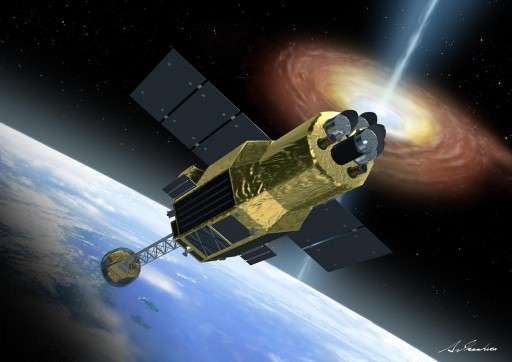
Second stage shutdown 13 minutes and 24 seconds into the flight sets in motion a quick sequence of events on the vehicle, dampening body rates for spacecraft separation just 50 seconds after SECO. Sent on its way at an altitude of 579 Kilometers, Astro-H will be tasked with the deployment of its solar panels, the acquisition of a stable orientation and the start of communications with the ground.
Over a period of days and weeks, the observatory will be readied for operations, deploying its Fixed Orbital Bench to reach the proper focal length required by the X-Ray telescopes, increasing the satellite’s total length to 14 meters.
With Astro-H on its way, the second stage will go through attitude maneuvers for separation of the three secondary payloads. ChubuSat-2 and 3 will be released at T+22 and T+27 minutes, respectively, while Horyu-4 follows at T+32 minutes. The final separation event would have been the release of the U.S. CubeSats 37 minutes after launch before H-IIA presses into end of mission ops.

